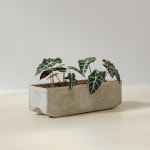





Willy Guhl
Fiber-cement
H 17 cm x W 60.5 cm x D 20 cm
Further images
This vase is part of the series of Eternit fiber-cement vases designed by Willy Guhl (1915–2004), the industrial design pioneer in Switzerland who also created the remarkable Loop Chair (1954).
When Eternit launched the first fiber-cement roof tiles in Europe, there were doubts about its resistance. So they created the vases to test if the material would be able to contain the water. The public liked it so much that the company kept them in the market. It was very common in the 1960s and 1970s to find pieces like this in Brazilian gardens and houses.
Though for indoor and outdoor environments, the Eternit vases were made originally in grey color but could be painted according to the customer’s taste. This model is called Swiss, and this one is in the original condition, with no painting.





